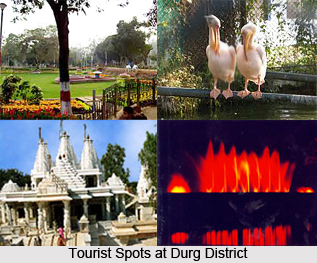Tourism in Durg District can only be brought under one roof when the Durg District is observed and geographically separated into two main physiographic divisions, the C.G Plain and the southern plateau. Sheonath, being the main River of the Durg District, is the main tributary of the Mahanadi River. Sheonath River has a total length of 345 km and has a tributary named the Tandula River. Durg also has another River knows as the Kharkhara.
History states that the district of Durg had been earlier a part of the "Dakshina` or the `Kosala` Rule and there is also evidence of the Ashoka Rule followed by the Marathas and then the British. It was in the year 1906; Durg was separated into a district. Also, according to the 2001 India Census, the district of Durg has a population of 2, 31,182.
Durg offers a number of tourist attractions for the visitors to enjoy. Places such as Shri Uwasaggaharam Parshwa Teerth, the Chandi Mandir, Ganga Maiya Temple, Deobaloda, Jain Temples of Nagpura are some of the major pilgrimages of Durg. In addition, this district also has other places that should not be missed paying a visit to such as Hindi Bhawan, Patan, Prachin Kila, Balod, Tandula, Maitri Bagh (zoo) and more.
 Gange Maiya Temple
Gange Maiya Temple
Gange Maiya Temple is the standing pillar of historical plethora of time. The history behind the construction of the temple is also curious. Once a fisherman catching fish in the pond near the village encountered an idol that got caught in the net; along with the fish and however hard he tried to immerse the idol in water sifting it from his net, it just remained stuck inside. Frustrated, he went home. That very same night, a tribal villager, Gond had a dream about "I am being ignored by fishermen and take me out and get installed". Taking this as a sermon from the goddess, Gond, the tribal went to the pond the next morning and retrieving the idol, installed it in a `kuccha` hut, near the village. As it was brought from water, hence the idol was named Ganga Maiya. Initially it was renovated by Shri Bhikam Chand Tawri and a fresh temple-shape was given. After this, the whole reconstruction process begun and is now the premiere place bustling with activities. The trust takes care of the temple and other multitasking, like cultural activities and problem solving of the villagers. Medical camps are arranged from time to time to serve the poor mankind; free medicines are distributed.
Uwasaggaharam Parshwa Teerth
On the other hand the Uwasaggaharam Parshwa Teerth is a Jain pilgrim centre, situated 10 km from Nagpura, in Durg district of Chhattisgarh. Constructed on the banks of the Sheonath River, the Uwasaggaharam Parshwa Teerth, Nagpura, Chhattisgarh enshrines an idol of Bhagwan Parshvanath with seven hoods in `Padmasana` posture (seated cross-legged). The entrance to this exquisite Uwasaggaharam Parshwa Teerth, Nagpura, Chhattisgarh is through a main gate, 30 feet in height. Shri Manibhadra Veer and Padmavati temples are built on the right and left side of the main temple respectively. The recently added garden, `Teerthhankar Udyan`, with its brilliant natural setting draws not only pilgrims but also tourists alike. Thousands of devotees visit the shrine, especially on full moon nights, considered an auspicious occasion.
Maitri Bagha is another tourist spot is a zoo cum children`s park, maintained by the Bhilai Steel Plant. An array of exotic animal and avian species is but the highlight of the zoo apart from lake, toy trains and others. The musical fountain, situated on the island in the artificial lake in Maitri Bagh is a dynamic spectacle which responds to the music in a way that interprets the style and rhythm of the musical performance. As the music plays, jets of water shoot in the air, twist, sway, pirouette, pulse, drum and skip with the beat - each movement lit by brilliant colours. Two shows are organized here in the evenings, on alternate days. White tigers are the main attraction of the zoo. Every year a flower show is organized here.
Shiva Temple, Deobaloda
Famous for its age old Shiva Temple, Deobaloda is a small town in Charoda and is at a distance of about 3 km from Bhilai. This temple is dedicated to Lord Shiva and its origin dates back to the 5th century. There is an interesting myth about a pond near this temple, which is believed to have an underground link leading to another town of Chhattisgarh, known as Arang. This creatively-built temple has sculptures of various deities such as Lord Shiva, Lord Ganesha and so on, along with carvings of dancing people, warriors, demi-gods and animals. In addition, this Shiva Temple of Deobaloda also has a Nandi Statue and a few erotic sculptures.



















